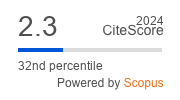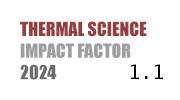THERMAL SCIENCE
International Scientific Journal
A BIOMECHANICAL MODEL FOR NUMERICAL SIMULATION OF THE EFFECTS OF GRADUATED COMPRESSION STOCKINGS ON HUMAN CALVES
ABSTRACT
Graduated compression stockings (GCS) have been employed for several decades to prevent and treat venous diseases of the lower extremities in humans. In order to investigate the mechanism of action of GCS on the lower extremity, a biomechanical model was constructed to simulate the magnitude and distribution of stresses exerted by GCS on the soft tissues, bones, and saphenous veins of the calf. The saphenous vein at the ankle was intercepted, and a flow-solid bidirectional coupling model was established to study the effects of GCS on blood flow return. The results demonstrate that the custom-made GCS can apply pressure to the calf in a manner that is consistent with the desired gradient distribution. The simulated and experimental values of the GCS exerting pressure on the calf surface exhibit a similar variation trend. Furthermore, the application of a GCS has been demonstrated to enhance blood return in the saphenous vein and to elevate the velocity of blood flow. The greater the external pressure applied to the calf, the greater the blood flow velocity of the vein in the calf. The discrepancy between the simulated and experimental values of the blood flow velocity is approximately 8%. The results provide valuable insights into the magnitude and distribution of pressure exerted by the GCS on each part of the calf, confirm the effectiveness of the GCS in promoting blood flow back to the calf veins, and lay the foundation for the accurate design and promotion of GCS.
KEYWORDS
PAPER SUBMITTED: 2023-10-04
PAPER REVISED: 2024-03-15
PAPER ACCEPTED: 2024-03-20
PUBLISHED ONLINE: 2025-07-06
THERMAL SCIENCE YEAR
2025, VOLUME
29, ISSUE
Issue 3, PAGES [1719 - 1729]
- Youn, Y. J., Lee, J., Chronic Venous Insufficiency and Varicose Veins of the Lower Extremities, The Korean Journal of Internal Medicine, 34 (2019), 2, pp. 269-283
- Ye, Z. D., et al., Reflection and Evaluation of Minimally Invasive Treatment of Varicose Veins in the Lower Extremities, Chin. J. Pract. Surg., 26 (2006), 10, pp. 2
- Guan, Y. B., Several Treatment Methods for Varicose Veins, Chin. Arch. Gen. Surg.: Electron. Ed., 14 (2020), 1, pp. 4
- Sun, Y. C., et al., Wearing State Based Pressure Distribution Study of Varicose Veins Care Compressive Stockings, Knitting Industries, (2018), 8, pp. 4
- Junior, O. A. S., et al., Compression Stocking Prevents Increased Venous Retrograde Flow Time in the Lower Limbs of Pregnant Women, Phlebology, 35 (2020), 10, pp. 784-791
- Liu, X. F., et al., Structural Characteristics and Research Progress of Medical Compression Stocking, Prog. Biomed. Eng., 40 (2019), 2, pp. 78-82
- Yang, K., et al., Development Status and Application of Graduated Compression Stockings, Tech. Text., 37 (2019), 5, pp. 1-5,11
- Zolotukhin, I., et al., A Randomized Trial of Class II Compression Sleeves for Full Legs vs. Stockings After Thermal Ablation with Phlebectomy, J. Vasc. Surg.-Venous Lymphat. Dis., 9 (2021), 5, pp. 1235-1240
- Li, X. T., et al., Varicose Veins of the Lower Extremity Secondary to Tricuspid Regurgitation, Ann. Vasc. Surg., 60 (2019), Oct., pp. 477e1-477e6
- Chiang, N., et al., Effects of Compression Therapy and Venous Surgery on Tissue Oxygenation in Chronic Venous Disease, Phlebology, 34 (2019), 7, pp. 474-480
- Bootun, R., et al., Randomized Controlled Trial of Compression After Endovenous Thermal Ablation of Varicose Veins (COMETA Trial), Ann. Surg., 273 (2021), 2, pp. 232-239
- Horner, J., et al., Value of Graduated Compression Stockings in Deep Venous Insufficiency, Br. Med. J., 280 (1980), 6271, pp. 820-821
- Zheng, Y. J., Tan, R., Research and Development of Health Care and Protective Function of Pressure Socks, Wool. Text. J., 49 (2021), 11, pp. 75-80
- Zhao, L., et al., A Three-Dimensional Biomechanical Model for Prediction of Garment Pressure in Pressure Therapy for Burn Patients, Thermal Science, 24 (2020), 4, pp. 2357-2365
- Dan, R., Shi, Z., Numerical Simulation of the Area Shrinkage Mass for the Waist of Elastic Pantyhose by Using FEM, Int. J. Cloth. Sci. Technol., 32 (2020), 2, pp. 244-254
- Yu, A., et al., Numerical Simulation of Pressure Therapy Glove by Using Finite Element Method, Burns, 42 (2016), 1, pp. 141-151
- Rohan, P.-Y., et al., Prediction of the Biomechanical Effects of Compression Therapy on Deep Veins Using Finite Element Modelling, Ann. Biomed. Eng., 43 (2015), 2, pp. 314-324
- Ghorbani, E., et al., Finite Element Modelling the Mechanical Performance of Pressure Garments Produced from Elastic Weft Knitted Fabrics, The Journal of The Textile Institute, 110 (2018), 5, pp. 724-731
- Zhao, L. H., et al., Compression Sleeves Design Based on Laplace Laws, Journal of Textile Engineering & Fashion Technology, 2 (2017), 2, pp. 314-320
- He, J.-H., et al., Gold Nanoparticles' Morphology Affects Blood Flow near a Wavy Biological Tissue Wall: An Application for Cancer Therapy, Journal of Applied and Computational Mechanics, 10 (2024), 2, pp. 342-356
- Swanson, E. C., et al., Evaluation of Force Sensing Resistors for the Measurement of Interface Pressures in Lower Limb Prosthetics, J. Biomech. Eng., 141 (2019), 10, 101009

